Creating engaging visual content requires a deep understanding of local culture and effective design principles. In South Africa, vibrant colors and storytelling techniques can significantly enhance audience connection, while platforms like Instagram, Pinterest, and Facebook offer unique opportunities for visual engagement. By prioritizing simplicity, brand consistency, and high-quality imagery, creators can elevate their visual narratives and foster meaningful interactions.
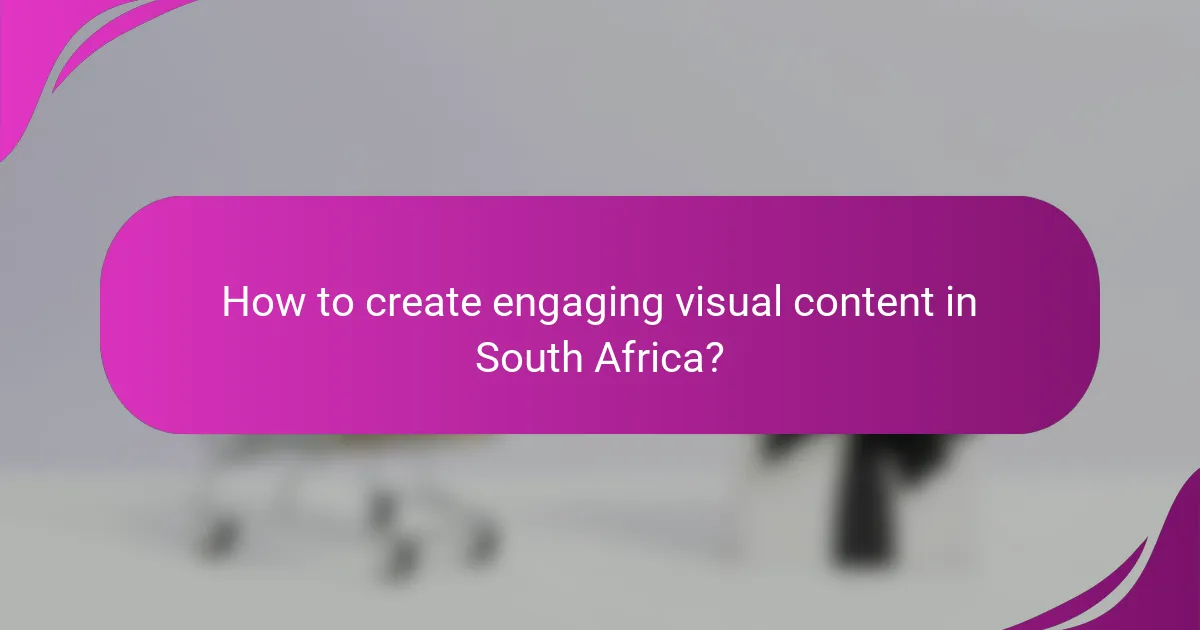
How to create engaging visual content in South Africa?
Creating engaging visual content in South Africa involves understanding local culture, using vibrant colors, and employing storytelling techniques. These elements can significantly enhance audience connection and interaction.
Utilize local cultural themes
Incorporating local cultural themes into visual content can resonate deeply with South African audiences. This might include traditional patterns, symbols, or references to local customs and events.
Consider showcasing elements from various South African cultures, such as Zulu beadwork or Xhosa attire, to create a sense of familiarity and pride. This approach not only engages viewers but also promotes cultural appreciation.
Incorporate vibrant colors and imagery
South Africa is known for its rich and diverse color palette, which can be effectively utilized in visual content. Bright colors can evoke emotions and draw attention, making your content more memorable.
Use imagery that reflects the natural beauty of the country, such as landscapes, wildlife, and urban scenes. This not only enhances aesthetic appeal but also connects with the audience’s sense of place.
Leverage storytelling techniques
Storytelling is a powerful tool for creating engaging visual content. By weaving narratives into your visuals, you can create a more immersive experience for your audience.
Consider using a clear beginning, middle, and end in your visual narratives. For example, a series of images that depict a local hero’s journey can inspire and engage viewers, making the content relatable and impactful.
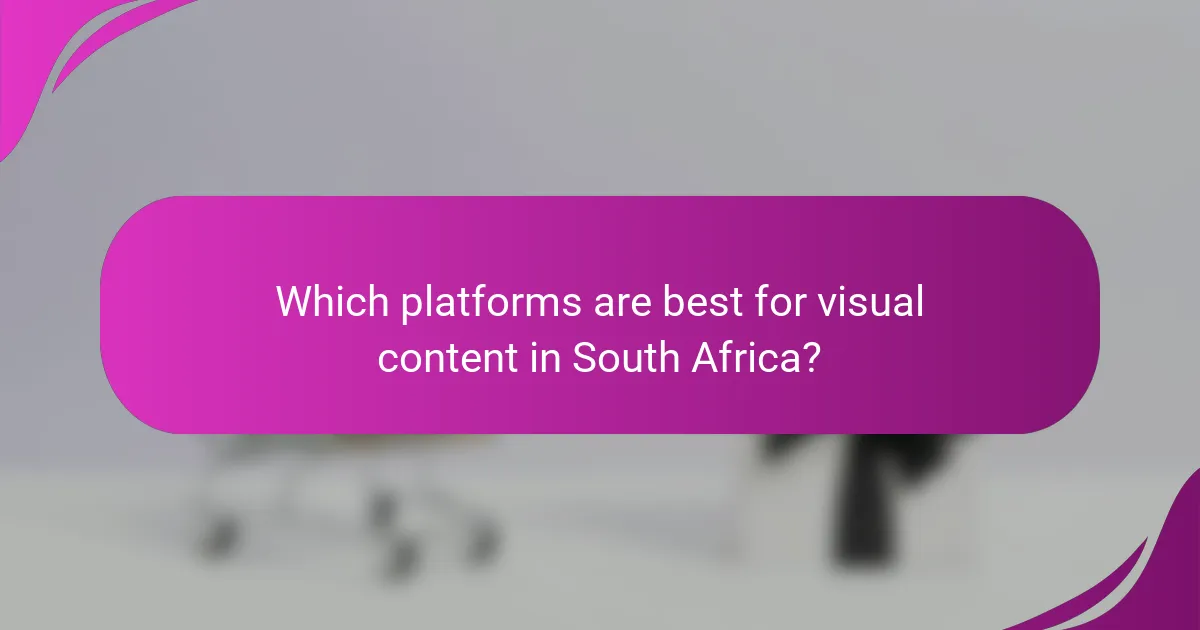
Which platforms are best for visual content in South Africa?
In South Africa, the best platforms for visual content include Instagram, Pinterest, and Facebook. Each platform offers unique features that cater to different aspects of visual storytelling, inspiration, and community engagement.
Instagram for visual storytelling
Instagram is a leading platform for visual storytelling, allowing users to share images and videos that capture attention. With features like Stories and Reels, creators can engage audiences through dynamic content that showcases their brand or message effectively.
To maximize engagement on Instagram, focus on high-quality visuals and consistent posting. Utilize relevant hashtags to increase visibility and consider collaborating with local influencers to reach a broader audience.
Pinterest for inspiration and ideas
Pinterest serves as a powerful tool for inspiration, allowing users to discover and save visual content across various topics. It is particularly effective for DIY projects, fashion, home decor, and recipes, making it ideal for brands targeting creative audiences.
To leverage Pinterest, create visually appealing pins that link back to your website or blog. Use keyword-rich descriptions to improve searchability and consider creating boards that reflect current trends or seasonal themes to attract more followers.
Facebook for community engagement
Facebook is a versatile platform that fosters community engagement through visual content such as photos, videos, and live streams. It allows brands to connect with their audience on a personal level, encouraging interaction and feedback.
For effective engagement on Facebook, post regularly and encourage user-generated content. Utilize Facebook Groups to build a community around your brand, and consider running contests or polls to increase interaction and keep your audience engaged.

What are the design principles for effective visual content?
Effective visual content design hinges on principles that enhance communication and engagement. Key aspects include simplicity, brand consistency, and the use of high-quality imagery, all of which contribute to a more impactful viewer experience.
Focus on simplicity and clarity
Simplicity and clarity are crucial for effective visual content. Overly complex designs can confuse viewers and dilute the message. Aim for clean layouts, minimal text, and a straightforward visual hierarchy to guide the audience’s attention.
Consider using ample white space to separate elements, making the content easier to digest. A good rule of thumb is to limit the number of colors and fonts to create a cohesive look that enhances readability.
Ensure brand consistency
Brand consistency is vital for visual content, as it reinforces brand identity and builds trust. Use the same color palette, typography, and logo placement across all visuals to create a unified appearance.
Establish brand guidelines that outline these elements and ensure that all team members adhere to them. This consistency helps audiences recognize your brand quickly, whether they encounter your content on social media, websites, or print materials.
Use high-quality images and graphics
High-quality images and graphics significantly enhance the appeal of visual content. Blurry or pixelated visuals can undermine credibility and distract from the message. Always opt for images that are sharp, well-composed, and relevant to the content.
When selecting images, consider using stock photo services or hiring a professional photographer to ensure quality. Additionally, graphics should be designed with attention to detail, using appropriate resolutions for different platforms to maintain clarity across devices.
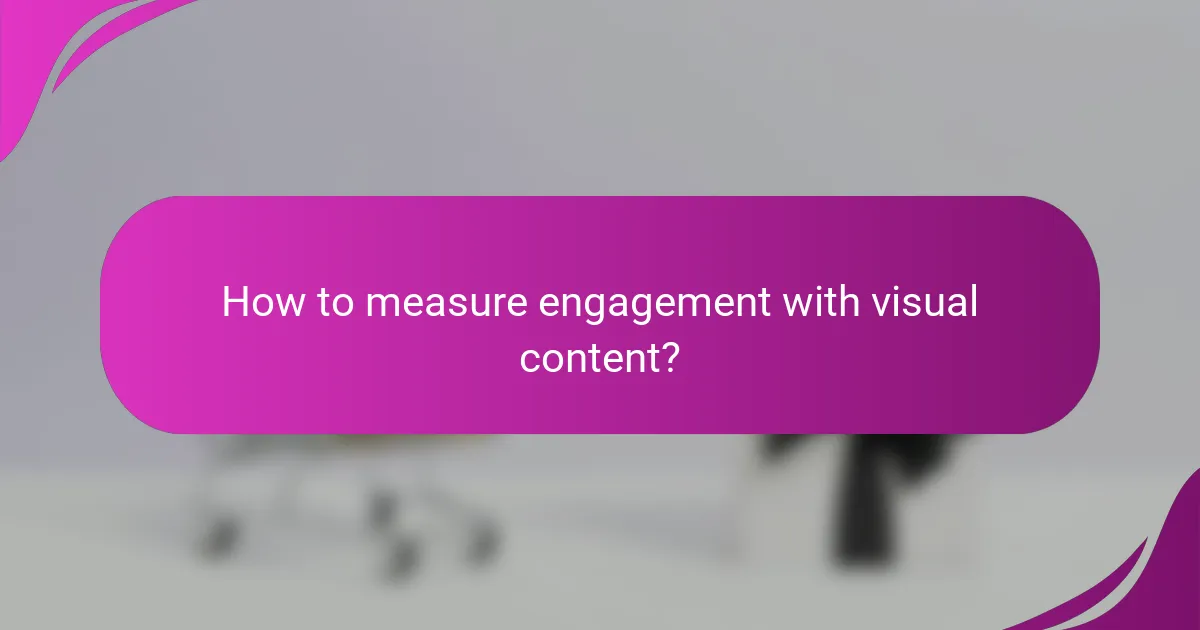
How to measure engagement with visual content?
Measuring engagement with visual content involves analyzing various metrics that indicate how users interact with your visuals. Key indicators include social media interactions, website traffic patterns, and data from analytics tools.
Track likes and shares on social media
Monitoring likes and shares on social media platforms provides immediate feedback on how well your visual content resonates with your audience. A high number of likes suggests that users appreciate the content, while shares indicate that they find it valuable enough to distribute within their networks.
Consider focusing on platforms where your target audience is most active. For instance, Instagram and Facebook are ideal for visually-driven content, while LinkedIn may be better for professional visuals. Regularly reviewing these metrics can help you adjust your strategy to enhance engagement.
Analyze website traffic and bounce rates
Website traffic and bounce rates are crucial for understanding how visual content affects user behavior on your site. Increased traffic following a visual campaign suggests successful engagement, while a high bounce rate may indicate that the content did not meet user expectations.
Utilize tools like Google Analytics to track these metrics. Look for patterns, such as whether users spend more time on pages with engaging visuals compared to text-only pages. Aim for a bounce rate below 40% for optimal engagement.
Utilize engagement metrics from analytics tools
Engagement metrics from analytics tools provide deeper insights into user interactions with your visual content. Metrics such as average session duration, pages per session, and conversion rates can reveal how effectively your visuals drive user actions.
For example, if users who view a specific infographic tend to spend more time on your site or complete desired actions, this indicates strong engagement. Regularly assess these metrics to refine your visual content strategy and improve overall performance.
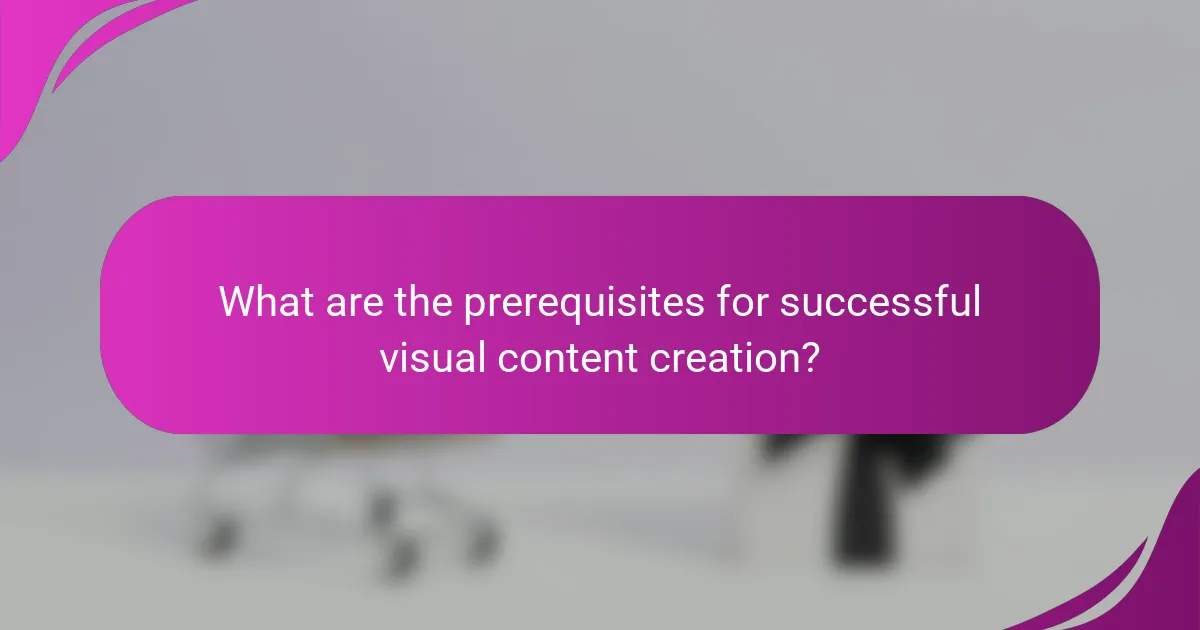
What are the prerequisites for successful visual content creation?
Successful visual content creation requires a deep understanding of your audience and well-defined objectives. These elements help ensure that the visuals resonate with viewers and achieve desired outcomes.
Understand your target audience
Knowing your target audience is crucial for creating effective visual content. This involves researching demographics, preferences, and behaviors to tailor your visuals accordingly. For instance, a younger audience may respond better to vibrant colors and dynamic designs, while a professional audience might prefer a more subdued and polished look.
Utilize tools like surveys or social media analytics to gather insights about your audience. This data can guide your design choices, ensuring that your visuals align with what your audience finds engaging and relevant.
Define clear objectives and goals
Establishing clear objectives and goals is essential for guiding your visual content creation process. Whether you aim to increase brand awareness, drive website traffic, or boost engagement, having specific targets helps shape your content strategy. For example, if your goal is to increase social media shares, focus on creating visually striking and shareable graphics.
Consider using the SMART criteria—Specific, Measurable, Achievable, Relevant, Time-bound—to define your goals. This approach ensures that your objectives are clear and attainable, allowing you to measure success effectively and adjust your strategy as needed.

How to choose the right tools for visual content design?
Selecting the right tools for visual content design depends on your specific needs, skill level, and the type of content you aim to create. Consider factors like ease of use, available features, and whether the tool supports collaboration if you’re working in a team.
Canva for easy graphic design
Canva is an intuitive platform ideal for users who want to create graphics quickly without extensive design skills. It offers a wide range of templates, images, and fonts, making it easy to produce professional-looking designs in a matter of minutes.
When using Canva, take advantage of its drag-and-drop interface and pre-designed elements. This can significantly speed up your workflow, especially for social media posts, flyers, and presentations. However, be mindful that while Canva is user-friendly, it may lack some advanced features found in more complex software.
Adobe Creative Suite for advanced editing
Adobe Creative Suite is the go-to choice for professional designers needing advanced editing capabilities. Tools like Photoshop, Illustrator, and InDesign provide extensive functionalities for image manipulation, vector graphics, and layout design.
Choosing Adobe means investing time in learning its features, as the suite has a steeper learning curve compared to simpler tools. However, the depth of control and precision it offers can justify this investment, especially for high-quality print materials and intricate digital designs.
Visme for presentations and infographics
Visme specializes in creating engaging presentations and infographics, making it a great option for educators and marketers. Its user-friendly interface allows users to combine text, images, and data visualizations seamlessly.
When using Visme, leverage its data visualization tools to create compelling infographics that effectively communicate information. This tool is particularly useful for those who need to present data in a visually appealing way. Keep in mind that while Visme offers many templates, customization options may be limited compared to more advanced design software.
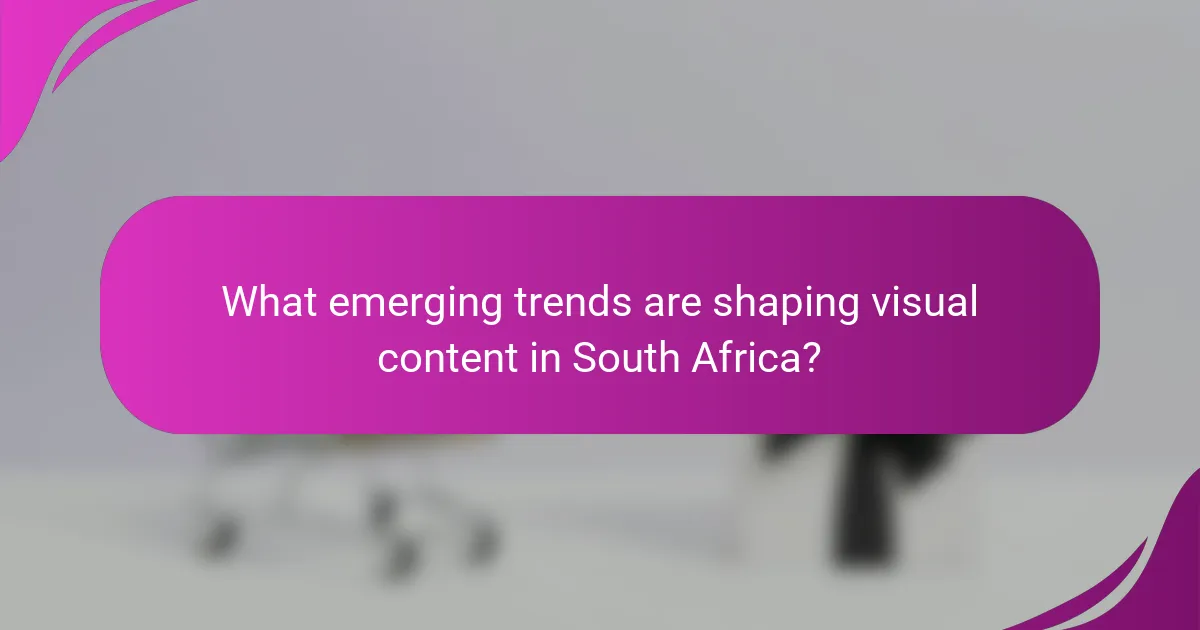
What emerging trends are shaping visual content in South Africa?
Emerging trends in South Africa are significantly influencing visual content creation and consumption. Key developments include the rise of mobile-first design, the popularity of short-form video, and an increasing focus on authenticity and local culture.
Mobile-First Design
Mobile-first design is crucial in South Africa, where a large portion of the population accesses the internet primarily through smartphones. This approach prioritizes creating content that is optimized for mobile devices, ensuring better user experience and engagement.
When designing for mobile, consider factors such as load speed, touch-friendly interfaces, and concise content. Aim for visuals that are easily viewable on smaller screens, using larger text and simplified navigation to enhance readability.
Short-Form Video
Short-form video content is rapidly gaining traction in South Africa, driven by platforms like TikTok and Instagram Reels. These formats cater to the audience’s preference for quick, engaging content that can be consumed in a matter of seconds.
To leverage this trend, focus on creating visually captivating videos that convey your message quickly. Use eye-catching thumbnails and compelling storytelling techniques to grab attention within the first few seconds.
Authenticity and Local Culture
There is a growing demand for authentic content that resonates with local culture in South Africa. Audiences are increasingly drawn to visuals that reflect their experiences, values, and heritage.
Incorporate local elements into your visual content, such as traditional art styles, local languages, or culturally relevant themes. This approach not only fosters a deeper connection with your audience but also enhances brand loyalty and trust.

